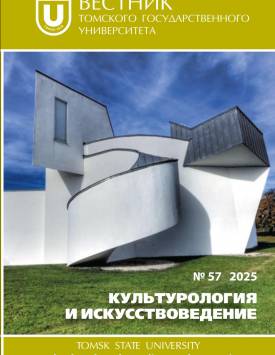To the question of the content, place and time of creation of the painting “Madonna and Child, Archangel Gabriel and young John the Baptist” from the collection of the Yekaterinburg Museum of Fine Arts
The article is devoted to the study of a painting by an unknown Italian artist of the turn of the XV-XVI centuries from the collection of the Yekaterinburg Museum of Fine Arts. The abundance of corrective records has significantly distorted the visual appearance of the work, which made it difficult to use the stylistic method of research. The content of the painting has a complex multicomposed character, in which three directions are well read. The Virgin Mary is depicted as the Madonna Humilitas. An important place is given to the theme of Holy Kinship. Finally, the presence of the Archangel Gabriel associatively contributes to the transition to the doctrine of Immaculata Conceptionis through the reference to the Annunciation. The latter suggests that the clients of the painting were influenced by the Franciscans. An important feature of the painting's composition is the complex movement of the Child, identified in the Warburg Institute's database as a separate iconographic motif, Child wriggling. As a result of the search, a number of iconographic analogues have been compiled, allowing us to assume that at the turn of the 15th-16th centuries there was a brief iconographic tradition of depicting the infant Christ in the “Child wriggling” pose in Italian and, more broadly, European painting, which became widespread in Florence and Milan. The technical and technological studies of the Ekaterinburg painting allowed us to get an idea of its layer-by-layer structure. It is painted on a wooden board. The ground is gypsum. pads. The construction of the plastic form in the carnation areas was carried out on grey linings with light flesh-tone paint. in the final layers covered with golden glazes. Coloured draperies in the underpainting were executed with dense bright layers of paint and covered in the areas of halftones and shadows with pigmented glazes. These techniques were fundamentally different from the system of painting developed in Florence at the turn of the XV-XVI centuries, where undercoats were created in lighter tonality and in the final layers were covered with denser and brighter colours. Comparison with the technology of the Milanese masters, who were members of Leonardo da Vinci's entourage, has shown the complete identity of technical and technological methods. This makes it possible to assume with a high degree of accuracy that the Ekaterinburg Madonna was created in the workshop of a Milanese master close to Leonardo da Vinci's circle. The author declares no conflicts of interests.
Keywords
Italy, turn of the fifteenth and sixteenth century, painting technology, iconographic analysis, Milanese schoolAuthors
| Name | Organization | |
| Pichugina Olga K. | Ural State University of Architecture and Arts named for N.S. Alferov | opich2008@ya.ru |
References

To the question of the content, place and time of creation of the painting “Madonna and Child, Archangel Gabriel and young John the Baptist” from the collection of the Yekaterinburg Museum of Fine Arts | Tomsk State University Journal of Cultural Studies and Art History. 2025. № 57. DOI: 10.17223/22220836/57/15
